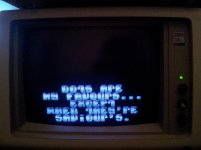What was the symptom when you tried to run it on the XT? It should have worked there - we used XTs to develop and capture it!
Yes, to be exact, the capture on YouTube is also the one that was shown at Revision. We captured it on the spot from my PC/XT.
My configuration was like this:
- IBM PC/XT 5160 from 1987
- Old style IBM CGA card
- Serial card
- Floppy controller
- 5.25" 360k FD drive
- Harddisk controller
- Seagate ST225 HDD
- 640k of memory
- Sound Blaster Pro 2.0
- IBM PC DOS 3.30 (note that the demo does not work with 2.x versions of DOS)
The HDD and serial port were only for convenience during development, and were not actually used during the demo.
The Sound Blaster Pro 2.0 was used for the capture, because it has a PC speaker connection on its mixer. This allowed us to tap the signal from the motherboard, and pass it through the SB Pro mixer, then out to a 3.5" jack, so we could connect it to the capture device, and adjust the levels for recording.
The SB Pro itself was not actually used during the demo of course, and in fact, no SB software was installed on my machine whatsoever. Not even a SET BLASTER-statement in my autoexec.bat.


